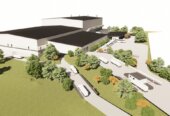
There’s still a twinkle in Haydn Finbow’s eye as he talks about his beloved Spitfires.
Through all the trials and pleasures of a life well lived, Haydn Finbow’s years spent piloting Spitfires during World War Two rank as the most memorable of times.
Even now, as he quietly reflects on his 94 years of life, Haydn becomes more animated when he talks about flying the iconic aircraft.
Spitfires, he reckons with a hard-to-conceal frisson of excitement, were just “perfect”. He had trained on Tiger Moths and Harvards, but for Haydn – and for many other young pilots of the day – there was nothing in the world quite like the Spitfire.
“It was like putting on wings and then just flying by yourself … like you were the only thing up there. And they went fast, really fast! They were so easy to fly.
“The first time I took off in one … I started up the runway and thought, “I’m actually going to be flying a Spitfire”. There were tears in my eyes, I don’t mind telling you.”
It’s unlikely that Haydn would have ever flown one at all had it not been for the outbreak of World War Two in 1939. The Spitfire became an iconic Royal Air Force fighter aircraft during the war, having been designed as a short-range, high-performance interceptor aircraft. It was the only British fighter to be in continuous production throughout WW2 – records show there were well over 20,000 of them made. That’s a lot of planes, and a lot of pilots flying them.

Haydn as a fresh-faced young aviator during the war years.
Haydn was born and raised in the small Suffolk village of Cotton. As he tumbled through an English countryside childhood with his contemporaries, his eyes were frequently drawn skywards to watch planes flying by as they traced a route between Norwich and Ipswich in the popular air races of the day.
They were mainly de Havillands and Tiger Moths, he recalls. “They flew directly over our house. I’d be down there waving madly at them.”
He left school at 14 with no clear pathway ahead, and ended up working as an apprentice for an uncle who was an agricultural engineer. Under his tutelage, Haydn learned about engines, tractors, farm machinery; there were few cars about for youngsters of his age, but everyone had a bike.
“We’d go riding on a Sunday. As soon as we heard a truck coming we’d jump off our bikes and watch him go past.”
But flying always captured his imagination. The evacuation of Dunkirk was taking place as Haydn was busy working on a farm, and he and other lads around his age were desperate to get involved.
“Dunkirk was going full blast. I think most of us were thinking we had to join up and go and stop those Germans.”
Keen to turn thoughts into actions, Haydn tried to do just that. He went along to the RAF recruitment office in Ipswich, but was advised to wait a while as he was only 17. “Don’t worry about coming yet, sonny,” he was told, “you wait until you’re older.”
He pressed them to be allowed to fill out a form, and just a month later received the news that he had been accepted and that he needed to report to London. His first billet was in accommodation commandeered for the recruits around the London Zoo area, and from there he was sent for further training to the north Welsh market town of Aberystwyth. At this early stage, the trainee pilots hadn’t been allowed within cooee of an aircraft. It was several months later that they transferred to Peterborough and were let loose on the Tiger Moths.
“If we could take the planes up, and put them down again safely, they reckoned we were qualified to fly. We were sent up to Scotland to board a ship – no more was said. We had no idea where we were going.
“But 17 days later we were in Halifax, Nova Scotia. It was an awful voyage. We were darting around the Atlantic with the U-boats chasing us. We’d go up 60-foot waves and the ship would sit there perched at the top before plunging down again.”

Haydn Finbow (extreme left) with his 610 (County of Chester) Squadron, RAF.
The recruits were moved around a fair bit, ending up in Florida and Georgia where they did further training with the US Army Air Corps before finally getting their wings and being transported back to Britain. Then, because the aircraft they had trained on in the US were different to those being used in Britain, the young airmen were sent to various flight schools to learn to fly the different craft.
Haydn joined No 610 (County of Chester) Squadron, RAF. Before long he was catapaulted into the deadly theatre of war, flying Spitfires on patrols over Europe before and after D-Day. Missions saw him pinpointing the exact position of downed RAF aircraft to alert pick-up crews, he flew as fighter escort on bombing missions, flew out to attack enemy ships or went on straffing missions to identified targets.
Much as he loved flying those Spitfires, terror was a constant companion. There was always the risk of being shot down – his aircraft was hit many times, and in his role as both pilot and gunner he was frequently plunged into the fast-paced turmoil of airborne attacks.
Haydn knows he had a few hits, but it was rarely possible in the white heat of the action to take stock of exactly what happened to the enemy aircraft he hit.
“You would always have the fear in your gut that this was your last flight,” he remembers.
So many young men were lost, many of them close mates. “Most of them were clobbered towards the end of the war. We all just thought, let’s bring thing to an end, so we all threw everything we had at it.”
There were sights he can’t un-see, smells he can’t un-smell. Just talking about it even now brings much of the horror back into stark focus.

Haydn Finbow with his Spitfire.
One narrow escape was when he was shot down in Germany. Fortuitously, he succeeded in bringing the aircraft to the ground relatively unscathed, but he landed between the German and the Allied lines, missing a house by inches and nudging the aircraft into the side of a hill at somewhere around 150 miles an hour.
“One of our sergeants with the 6th Air Battalion division shouted at me, “For Christ’s sake, get out of here!”. He said there were Germans behind the hedge, and told me to follow him.”
That episode resulted in Haydn being hospitalised for a while, crammed in with injured military personnel of all nationalities. “So many had awful injuries … some were burned, they’d been in the tanks. The smell was awful.”
From there he was taken to a hospital in Brussels for two weeks – and then the war ended.
Once back in the UK, Haydn spent the next two years putting his life back together. Like so many others, the experiences seared into their memories made it difficult to adjust back into civilian life.
“We just made the most of getting out of it alive, I suppose. We’d be off at the pubs, getting drunk and chasing women. It took a while for us to settle down.”
When he did, he married Patricia, a girl he knew from his home area, and the couple raised three daughters. With the war and its immediate aftermath behind him, Haydn never flew again and he has been left with an abiding distrust of travelling in boats.
But there are memories he has held dear from those days. The discipline, the camaraderie and the closeness of friends facing a common danger has him swell with pride.
Among those friends was the late Group Captain Colin Gray, who ended the war as a decorated RAF officer and the top New Zealand fighter ace of WW2. Another squadron mate was Ian Douglas Smith, the man born in what was then Southern Rhodesia, who went on to become a farmer and politician, and who became Rhodesia’s Prime Minister from 1964 to 1979.
“His bunk was next to mine – we used to talk about all sorts of things. I would never have thought he’d have gone on to become a politician,” said Haydn. “But I did follow his career for years after that.”
Haydn’s working life took off in various directions. He went back to work with his uncle for a while, working with agricultural equipment, draining fields, working in the factory, then he did a few other things before the couple decided to migrate to New Zealand in 1974.
They visited New Zealand House in London and decided they liked what was on offer. Although he was almost 50 at the time, both Haydn and Patricia quickly found jobs in the Hamilton area, and they started their new lives.
Haydn took on the franchise for a kitset-type of home building, and went on to build hundreds of homes across the region. They moved to Tauranga; it was there that Haydn was widowed 12 years ago, and there he remained until he was 92, when family brought him to Cambridge to be closer to them.
Despite the horror and sadness he experienced during the war, Haydn believes those years flying Spitfires were among the best times of his life.
“The war was a terrible time for everyone, but flying was somehow different. I did think about flying in a civilian capacity once the war was over, but the planes were getting bigger, they carried more people. I didn’t think I’d like that.”









